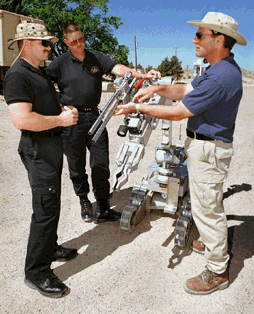
He’s fearless. He has no family. And he doesn’t mind a dangerous mission.
Eighteen months ago the Albuquerque Police Department welcomed into its bomb disposal unit the Remotec Andros 5A — a commercial robotic vehicle with three cameras, a gripper, and a double-barreled bomb disabler originally developed by Sandia’s Chris Cherry (5932).
But because APD has only a part-time bomb squad and lacks the time and budget to train its officers to use the robot, the bomb techs are uncomfortable using the robot and tend to think about it for simple, surveillance-type operations only. And when they have to deal with a suspicious package up close, they do it the tried-and-true way — they suit an officer in 80-pounds of Kevlar bomb gear and send him or her into danger.
That’s changing thanks to an innovative project between the APD and Sandia’s Intelligent Systems and Robotics Center, sponsored in part by Community Involvement and Issues Management Dept. 12650.
Practice and understanding
Beginning in March Phil Bennett of Intelligent Systems Principles Dept. 15221 has hosted a series of daylong training sessions with APD bomb techs. During the sessions, the officers use their robot to “render safe” mock bombs in realistic scenarios. Phil created the scenarios based on a national survey of top bomb squad challenges.
The bomb techs get needed practice using the Andros in situations like those they face during bomb scares. In return, Phil gains an understanding of the bomb squad’s real-world needs and problems, which he hopes to translate into a technological solution.
The key to that solution, he says, is SMART, for Sandia Modular Architecture for Robotics and Teleoperation, a patented software-based robot control architecture pioneered by Bob Anderson of Mobile Robotics Dept. 15252.
More than just its hardware
A robotic system is more than just hardware, explains Phil. “When you assemble a robotic system, you need a control system that integrates the hardware components electronically in such a way that you have a stable, useful tool,” he says.
SMART’s “stackable” control modules — one for each robot component or function — enables the rapid assembly of off-the-shelf equipment into a working system. But what’s unique about SMART, says Bob, is its patented nonlinear control algorithm, a piece of software that allows a variety of components, perhaps from different vendors, to be integrated into a single system and work correctly the first time.
“SMART overcomes obstacles to system stability in an unstructured environment,” he says, “which gives the operator the freedom to decide what needs to be done without having to worry about the details of making it work.”
Worrying about ‘what’ rather than ‘how’
SMART has been demonstrated on robots for accident response and waste cleanup.
Each component on the Andros today is controlled separately, so to perform a task — say, to pick something up with a gripper — the operator moves the robotic arm’s joint angles one at a time until the gripping tool is in the right place. This is difficult and can lead to operator fatigue and errors. Errors, of course, are unacceptable in a bomb tech’s world.
A SMART-based robot with associated sensors and other tools could be “pre-programmed,” in a sense, using software control sequences that allow it to grip tool A or go to point X, rather than having individual movements controlled separately.
“That would be useful, for instance, when you need to reach through a car door, grab an object, and back out without whacking the door,” says Phil.
This summer Phil and Bob plan to take the knowledge they’ve gained from working with the APD into the lab, where they’ll design a suite of SMART-based control modules that they think will allow the bomb techs to accomplish their most common or challenging tasks. Then this fall they hope to roll out a developmental robot with SMART on it and let the APD put it through its paces during a second series of training sessions.
Ultimately Phil says he’d like to see the FBI endorse the use of SMART on bomb squad robots nationwide. The FBI is helping advise Sandia on the project. In addition, a few robot manufacturers are interested in SMART, as well.
Making the Andros a more valuable tool
“We’ve had this robot for a year and a half now, and in that time we’ve had very little training time with it,” says Capt. Ray Schultz, who heads the APD bomb disposal unit. “Sandia is going to make improvements in the software that will improve the efficiency of the way my guys interact with it, and that could save the APD tens of thousands of dollars in training time.
“It might also make this robot a more valuable tool by making it useful for not just bomb scares but also hazmat spills and other types of calls,” he adds.
“This is the most practice we’ve had,” said APD bomb tech Stephen Chester on a recent Thursday morning as he tried to command the Andros 5A to grip a disablement tool and place it near a simulated bomb on a car seat. “We’re just now gaining the confidence to use it. The more we use it, the better we will get.”
Last modified: May 22, 2000